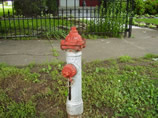 |
|
The History of Cowan Fire Department By L. Jarod Pearson The citizens of Cowan coordinated efforts to fight and contain fires in the community for the better of the town's history. In the late 19th Century a group of private citizens, led by the Hawkins family, built and installed underground water lines that fed the town’s very first fire hydrants. The only surviving example (as far as we know) is on West Cowan Street in front of the home of Rev. and Mrs. B.J. Hancock. These tiny hydrants carried about as much water pressure as a modern-day household plumbing system.
The first fire vehicles in Cowan were two-wheel carts carrying a hose drum. We speculate that these vehicles were built from old railroad mail carts. Initially they were pulled by a few strong men, but were later modified for easy hitching to horses. In those days Cowan did not have a dedicated fire team. Instead, anyone and everyone in the vicinity of a fire was expected to pitch in and help.
On May 6, 1925, the City Government established the first official fire zone along Tennessee Avenue (at the time known as Wetmore Street) that included a more restrictive building code and rules for fire prevention.
On November 11, 1930 Mayor Thorogood authorized the installation of four standard fire hydrants using a larger 4” pipeline. Strangely, these hydrants were installed and overseen by Tennessee Electric Power Company and not by the fire department or water department.
In the mid-1940’s, the Mayor and Aldermen purchased (for $600 dollars!) a 1940 midship mounted Ford pumper truck. This valuable piece of equipment was previously owned by Camp Forrest in nearby Tullahoma. On February 25, 1946, the Mayor and Aldermen called a town meeting in conjunction with the Winchester Fire Department for the purpose of formally establishing a Cowan Fire Department. On May 20, 1946, upon recommendation by the State Inspection Bureau, the Mayor and Aldermen passed Ordinance #137 providing for the formal organization of Cowan Fire Department. The payment provisions were $2 per fire to each fireman and $3 per fire to the fire chief.
In the early 1950’s concern was raised that Cowan’s water system could not meet the fire safety demands of a growing community. The State Inspection Bureau also cited that the 1940 pumper could not deliver the necessary 500 gallon per minute threshold. The truck was sent to St. Louis for a full recondition and upgrade. Soon thereafter, a 1,000 gallon GMC water tender was purchased.
Sadly, the vintage 1940 fire truck failed another inspection and was forced into mandatory retirement. It was replaced in 1964 by a more powerful 750 GPM model from Central Fire Truck in St. Louis.
Besides the obvious task of fighting fires, Cowan Fire Department has historically been on the forefront of coordinating charity drives, educating the public on fire safety and prevention, and providing early response to medical emergencies.
Today’s Cowan Fire Department is on the cutting edge for professional training, top-notch equipment, and vital technology such as GPS. The recent acquisition of a new fire truck plus the expansion of fire hall No. 1 shows that Cowan Fire Department is adapting quickly to the needs of the community.
Did you know…?
For several decades, Cowan Fire Department alerted its members (and everyone else in town!) using an electric-powered air horn.
Before the widespread use of two-way radios and pagers, Cowan Fire Department used the infamous “fire phone” system. It would send a special ring through the household phone lines and then a dispatcher would speak through the system in conference call fashion. (Some residents remember how often the system rang when there was nothing to report!)
A huge concern for several decades was the fact that some 40% of the town lives on the west side of the railroad tracks, but the fire hall has always been on the east side. This situation was remedied in the early 1990’s with the construction of Fire Hall No. 2 on Oak Street.
The succession of Cowan Fire Chiefs is as follows: Elmore Douglas, Buster Lasater, Buzz Cowan, Paul Champion, Kenneth Myers, Charles Abbott, Bud Norvell, Raymond “Chick” Tucker, and Tommy Myers.
(Information for this article is taken from the writings of Evamaria Krischell, editor of the Cowan Bell, 1974.)
|
|
